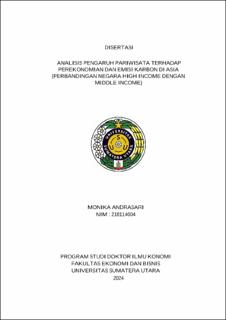| dc.contributor.advisor | Hasyim, Sirojuzilam | |
| dc.contributor.advisor | Syafii, M | |
| dc.contributor.advisor | Tanjung, Ahmad Albar | |
| dc.contributor.author | Andrasari, Monika | |
| dc.date.accessioned | 2025-01-24T03:53:08Z | |
| dc.date.available | 2025-01-24T03:53:08Z | |
| dc.date.issued | 2024 | |
| dc.identifier.uri | https://repositori.usu.ac.id/handle/123456789/100587 | |
| dc.description.abstract | This study analyzes the impact of tourism on the economy and carbon emissions in Asia by comparing high-income and middle-income countries during the period 2009-2019. Using panel data regression models and Seemingly Unrelated Regression (SUR), it was found that tourism revenues significantly increase Gross Domestic Product (GDP) in high-income countries, while the impact is insignificant in middle-income countries. Gross Fixed Capital Formation (GFCF) positively affects economic growth in both groups, with a more substantial impact in middle-income countries. The labor force significantly contributes to GDP in both groups, with a greater impact in high-income countries. The use of information technology positively and significantly impacts economic growth in middle-income countries but is insignificant in high-income countries. Tourism significantly contributes to the increase in carbon emissions in both groups, with a greater impact in high-income countries. Urban population growth reduces carbon emissions in high-income countries but increases emissions in middle-income countries. The value-added of the industrial sector significantly impacts carbon emissions in high-income countries, while the impact is insignificant in middle-income countries. The value-added of the service sector significantly contributes to carbon emissions in high-income countries but is insignificant in middle-income countries. In conclusion, tourism has a greater impact on carbon emissions than on economy in both groups of countries, emphasizing the need for sustainable tourism strategies that consider environmental impacts while supporting economic growth. | en_US |
| dc.language.iso | id | en_US |
| dc.publisher | Universitas Sumatera Utara | en_US |
| dc.subject | Tourism | en_US |
| dc.subject | Carbon Emissions | en_US |
| dc.subject | Asia | en_US |
| dc.subject | Seemingly Unrelated Regression | en_US |
| dc.title | Analisis Pengaruh Pariwisata terhadap Perekonomian dan Emisi Karbon di Asia (Perbandingan Negara High Income dengan Middle Income) | en_US |
| dc.title.alternative | Analysis of The Effect of Tourism on Economy and Carbon Emissions in Asia (Comparison Of High Income And Middle Income Countries) | en_US |
| dc.type | Thesis | en_US |
| dc.identifier.nim | NIM218114004 | |
| dc.identifier.nidn | NIDN0018086303 | |
| dc.identifier.nidn | NIDN0029126505 | |
| dc.identifier.kodeprodi | KODEPRODI60001#Ilmu Ekonomi | |
| dc.description.pages | 211 Pages | en_US |
| dc.description.type | Disertasi Doktor | en_US |
| dc.subject.sdgs | SDGs 8. Decent Work And Economic Growth | en_US |


